DAYS 150-163
JAPAN
DAY 150 Tuesday, June 13. Naha
I wasn’t feeling well, so instead of going out and about we just went ashore for the mandatory face-to-face with Immigration and returned to the ship.
DAY 151 Wednesday, June 14. Naze/Amami
We took a ship’s tour, “Cultural Amami.” I enjoyed it. The first stop was Amami’s municipal park and museum. The museum was kid-oriented. It had maps and interactive displays, and a small, old-fashioned home with a thatched roof, tatami mats on the floor, a brazier, a loom; and a mannequin of an old man wearing a straw hat and eyeglasses—and a transistor radio. It was great fun to walk around—carefully, as the roof beams were eyebrow-height for me.
At the other end of the park was a beautiful art gallery devoted to the art of a local man. Most of it was very traditional work, but late in his life he tried some abstract painting and some landscapes that reminded me of the Belgian painter Rousseau.
The second stop was a workshop for making cloth for kimonos. The grounds were a beautifully manicured garden. Their product is beyond luxury. The cloth itself is a work of art and exquisite craftsmanship. Their cloth is black, but skeins of raw silk thread are bound together in a way that certain spots are left white, and once dyed they are woven together to form patterns. Amazing!
The dying itself is done in a very time-honored manner, involving about 80 steps, alternating between a chemical bath and then scrubbed by hand in the special, iron-rich mud. We saw this man knee-deep in the mud, processing some raw silk.
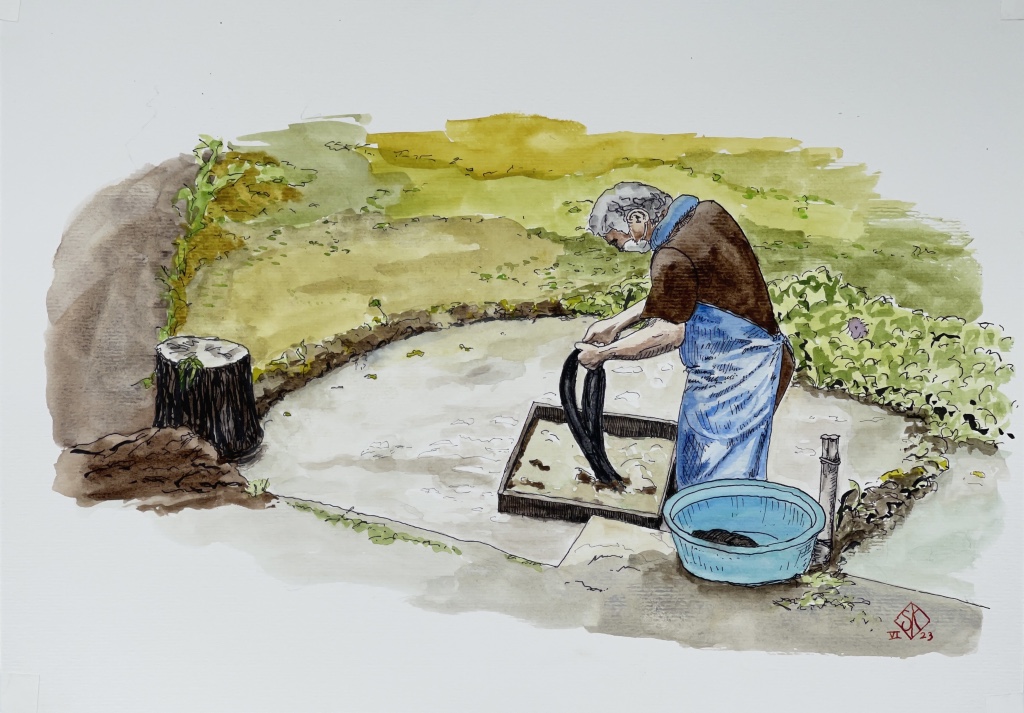
DAY 152 Thursday, June 15.
Kagoshima is a port city reputed to be the first place industrialization was introduced in Japan. We went to a shopping mall that was made in a pattern we’d see again in Japanese cities—a covered street between three-story buildings on either side.
Kagoshima’s volcano lies across the bay, shrouded in clouds, and someone flying a kite incredibly high made the scene of my only plein-air sketch for this collection.
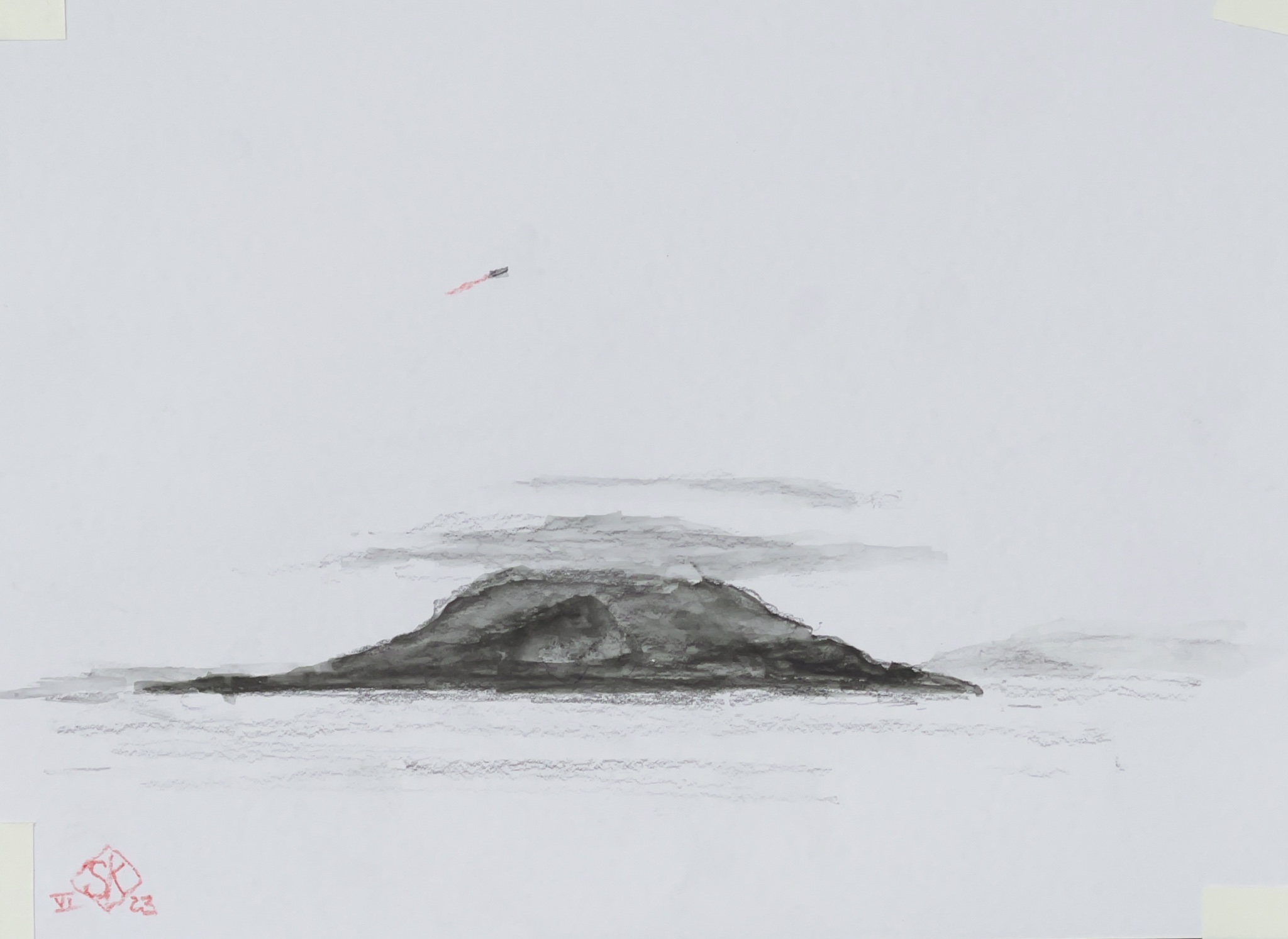
DAY 153 Friday, June 16. Hiroshima
We took a trip to Miyajima, the island across the way from the city proper. It is the site of the famous “floating” gate. Only it was low tide, so its base was visible and we could walk right up to it.
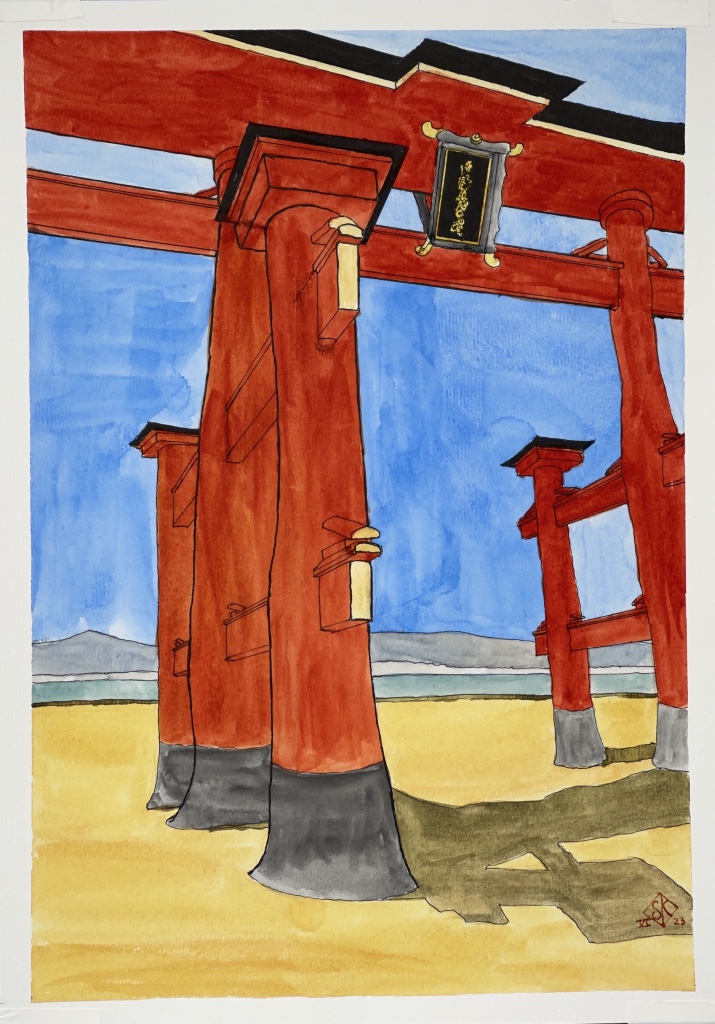
For lunch we visited a little restaurant there and discovered the local specialty, okonamiyaki. It’s a kind of sandwich we liked so much we plan to make it at home.
DAYS 154-155 Saturday and Sunday, June 17 &18. Kobe
I wanted very much to see Kyoto, which I was told one could see traditional Japanese buildings and streets, and where some of the old traditions were honored more than anywhere else. Well, the ship’s tour to Kyoto was pleasant, but was entirely different. Instead we visited three historic sites and stopped for a classic bento box lunch.
On Sunday we went shopping and bought the pen I had read so much about, the classic Custom Heritage 912 by Pilot, with a flexible gold nib. If you draw with a pen, you’ll want one of these. It doesn’t disappoint.
As far as a sketch goes, I’m struggling to do sketches for this location and the next day’s. I will post something as soon as I can.
DAY 156 Monday, June 19. Shimizu
We visited the Kano Toshugo Shrine and the Nihondaira Yume Terrace, which is noted as the best place to view Mount Fuji, and from which Hokusai drew one of his famous pictures of Mount Fuji. Unfortunately Mt. Fuji is notoriously “shy,” in our guide’s words. They say in the winter you’d have better luck. When I talked about it with David Bull, who you’ll meet later, he told me he lived in this area of Japan for 10 years before he was able to see it.
DAYS 157-158 Tuesday and Wednesday, June 20 & 21. Tokyo.
Tuesday we took the subway to Ginza. On the famous intersection where we see videos of thousands of people crossing from all four corners at once, every which way, there were very few pedestrians. There were all the famous Fifth Avenue stores, but also more empty shops than I expected. In general it reminded us both of New York’s Fifth Avenue. One amusing thing though, was as there is a terrific Japanese restaurant just off Fifth Avenue, here I found a “beer hall and restaurant” called “Butcher’s Grill New York.
Wednesday we hopped the subway again, this time to the Asakusa area. We got lost. Apple Maps had us get off the wrong stop, luckily the Japanese are very kind and helpful, and we were sent in the right direction. Our goal was one I was very eager for. More than two years ago I had ordered a print of Hokusai’s “Great Wave.” It is in such demand they have to rest the printing blocks every so often, and finally, exactly a year before our trip, the shop emailed me that they were going to send it. Stop! I told them. I’ll come and pick it up in person!
Now I was on my way. The shop is called Mokuhangan, Japanese for “woodcut print.” I was greeted very warmly and got to meet the owner, and the carver for this print, David Bull. I’m a big fan, though the kind of printing I do is different.
Asakusa is a beautiful part of the city, with winding pedestrian streets, quite unique, I think. I suspect we caught Tokyo on a holiday because one Asakusa street in particular was crowded with people dressed up in traditional costumes, buying souvenirs, fast food from shops along the street, also buying good luck tokens blessings from the shrine. One family in particular caught my eye.
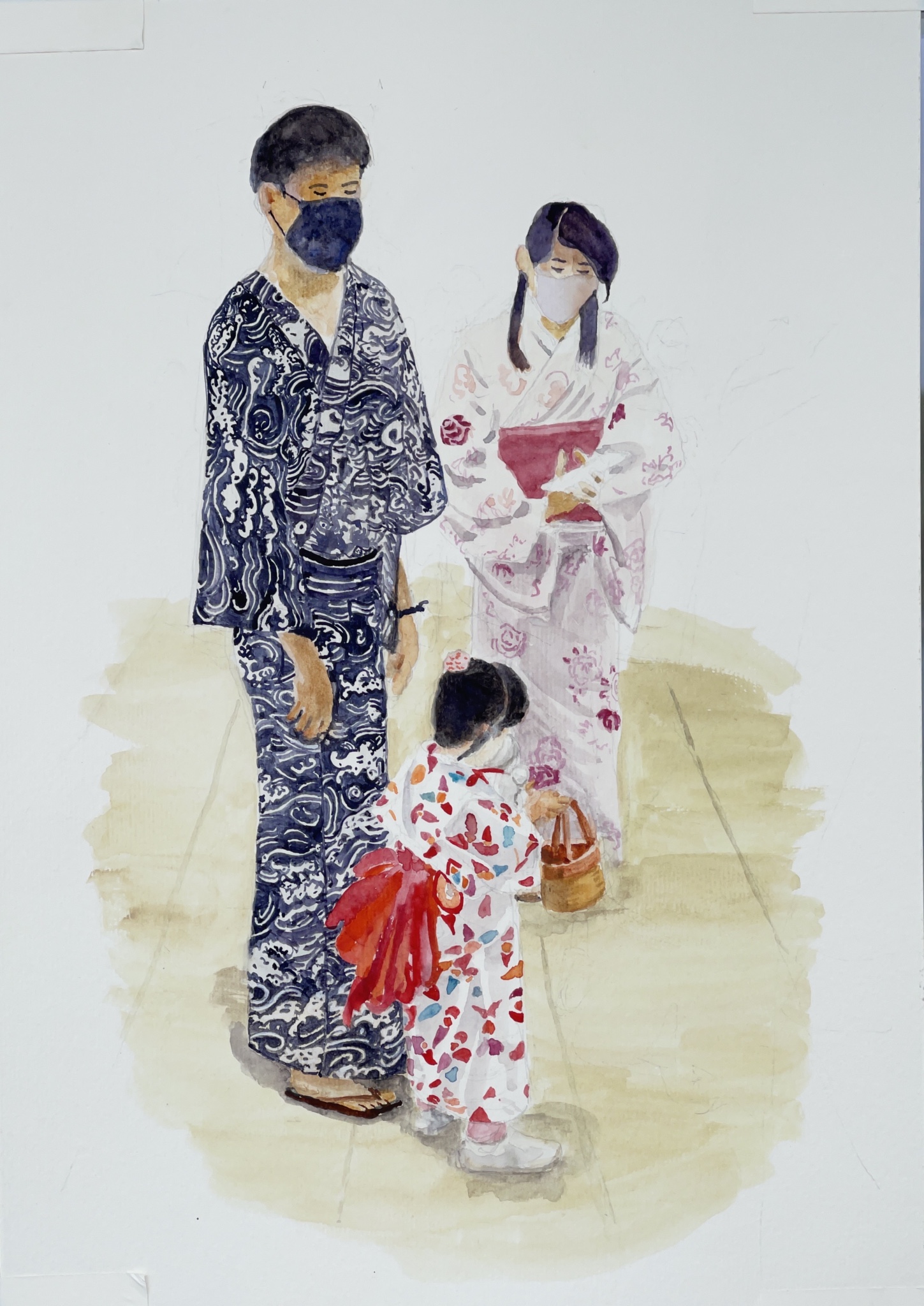
DAY 160 Friday, June 23. Aomori
After a day at sea we got a big welcome in Aomori, on the island of Hokaido. The pier was lined with drummers and dancers, some in traditional get-ups, some in school costume. In the cruise terminal we were greeted by girls from the high school’s English language club performing on kotos and demonstrating Japanese calligraphy and origami.
Aomori is known throughout Japan for its apples. I’m told that the first, perfect apples of the season can go for hundreds of dollars apiece. It’s also the center for making traditional Nahuta floats for the mid-August Japanese celebration honoring their ancestors. We visited a museum/warehouse for the floats. They are in effect giant lanterns that can stretch 10 meters long, 3D depictions of scenes from Japanese mythology, of heroes and deities fighting monsters and other forces of evil. I think the prettiest was of a moon goddess expelling a demon by playing her flute. I painted part of it, showing the wire frame that gives it structure.
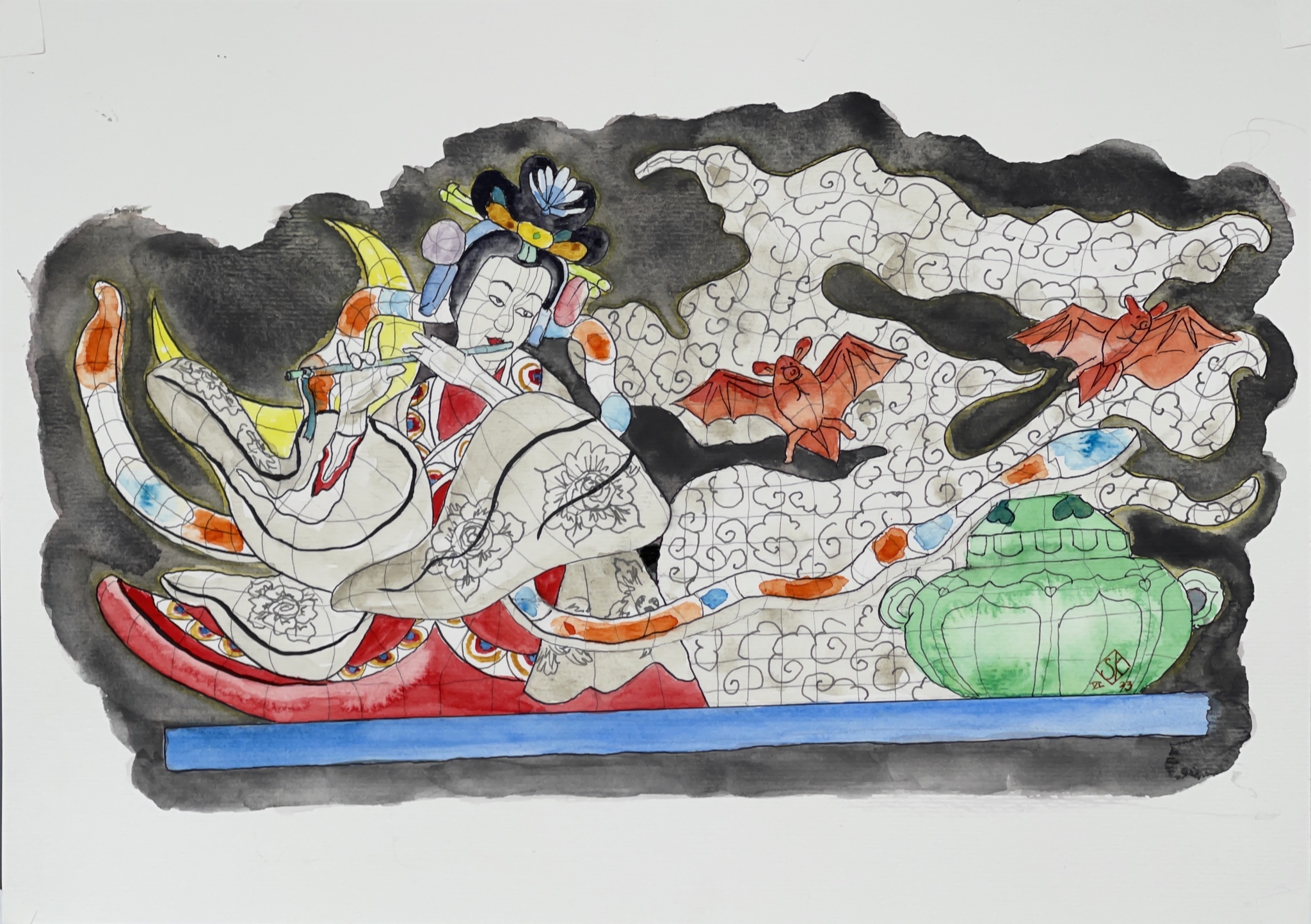
DAY 161 Saturday, June 24.
Hakodate was one of the Japanese first ports to open to Western trade. Some of the traders’ Western-style houses still stand, in a reserved neighborhood called Motomachi. Warehouses along the waterfront from those days are now high-end shops. Among them we finally found a restaurant serving ramen. It was delicious.
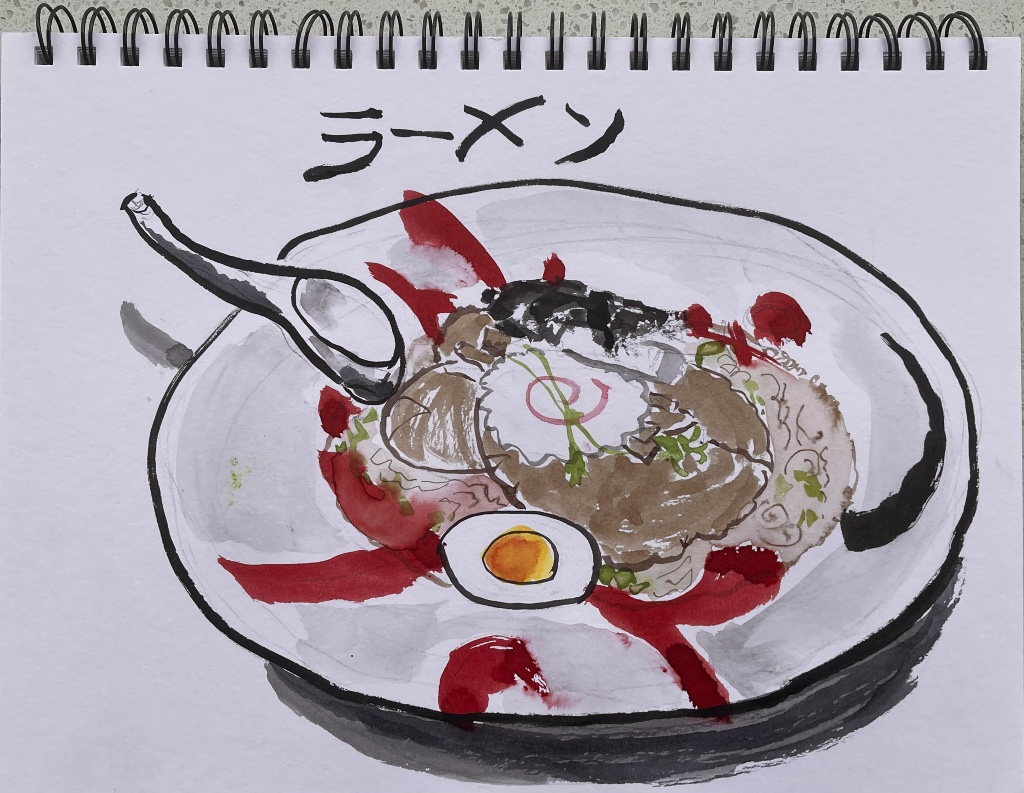
DAY 162 Sunday, June 25.
Kushiro is a busy fishing port on the eastern side of Hokkadi. The fish market was fantastic. I bought some squid ink and used it to draw a particularly menacing—and expensive—crab.
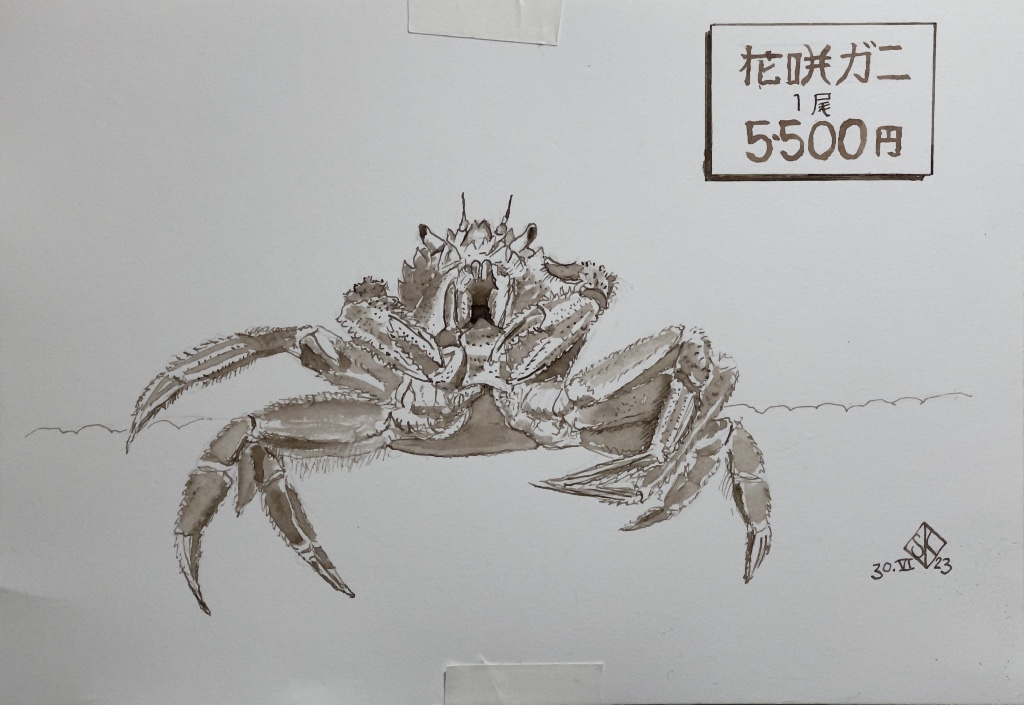
Two hours out of Kushiro the ship had to turn around and return. Someone had a cardiac event and had to be medevacced. The ship has no helicopter landing pad, so this had to be done with the ‘copter hovering above the forward top deck, Deck 11. The ‘copter circled and circled for the better part of an hour before picking up the patient. This was because their protocol says no one except the evacuee was to be on deck, not even the doctor. And people kept sneaking out onto Deck 9 to catch a peek!
DAY 163, at sea.
On our way to Alaska, which will take about five days, depending on how you count them, as we will be crossing the Date Line. The days are Arctic-summer long, with hardly any night at all. Today’s weather is bright, but foggy, and just a little cool.
